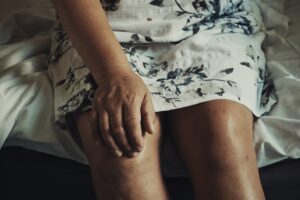You may have had sore muscles the next or two days after doing any activity. Maybe it was in the spring when you spent four hours planting flowers, this fall when you went up and down the stairs to the Mont-Royal belvedere or even when you resumed your exercise routine after a break for a few weeks? While it could be uncomfortable, if not a little bothersome, the pain you felt was probably the simple result of the process that occurs when muscles are strained in an unusual way.
Without you realizing it, several mechanisms go into action in your body when you move. If you do a new physical activity, if you perform a movement that you have not done for a long time, or if you exert an effort that exceeds the intensity to which your body is accustomed, it is likely that muscle pain occurs in the muscles hours and days after. Indeed, as a result of such efforts, the fibers that make up your muscles undergo micro-tears which are responsible for the muscle pain you feel. This discomfort should normally go away within 12 to 48 hours of physical activity. In themselves, these micro-tears are not harmful : they allow your muscle to grow and thus increase your muscle strength!
Listen to your body
It is important not to confuse muscle pain resulting from exerting more than usual with another form of pain which could be the manifestation of an injury. If you experience fatigue or heat in your muscles during movement, you shouldn’t be concerned. However, if movement causes pain in or around a joint (neck, shoulder, knee, ankle, etc.), you should reduce the load, change your movement, or stop exercising.

In any physical activity, the key is progression. To benefit from it, to become stronger, more enduring, you have to get out of your comfort zone, push your limits each time, but just a little each time. It’s the sum of all these little extra efforts that will allow you to improve, in complete safety. While it is true that these efforts can lead to certain discomfort since the benefits will be greater: the strength and muscular endurance that you will gain will allow you to practice your leisure activities more easily. Even daily activities like washing dishes, getting out of the car, carrying bags and cleaning will seem easier! The more you use your muscles, the more strength they will be able to produce. Then you will do the movements with less effort!
In conclusion, know that you don’t have to feel this muscle pain to experience the benefits of physical activity. But if it does occur, do not be alarmed! However, if your pain is acute, feels abnormal, or you are in any doubt, it is important to talk to your healthcare professional before continuing with your training. And if you live with chronic pain, you have to take a very gradual approach.
Advice from the kinesiologist
- If you experience muscle pain in the days following physical activity, give your body time to recover, but don’t stop moving completely, choose lighter aerobic activity (walking, cycling, swimming) instead.
- The effects of training should not interfere with your daily activities. If so, decrease the intensity of the exertion the next time.
- Consult a kinesiologist to make sure you are progressing adequately in your training. It will help you to gradually increase the difficulty of the exercise and the weights used.







Comments